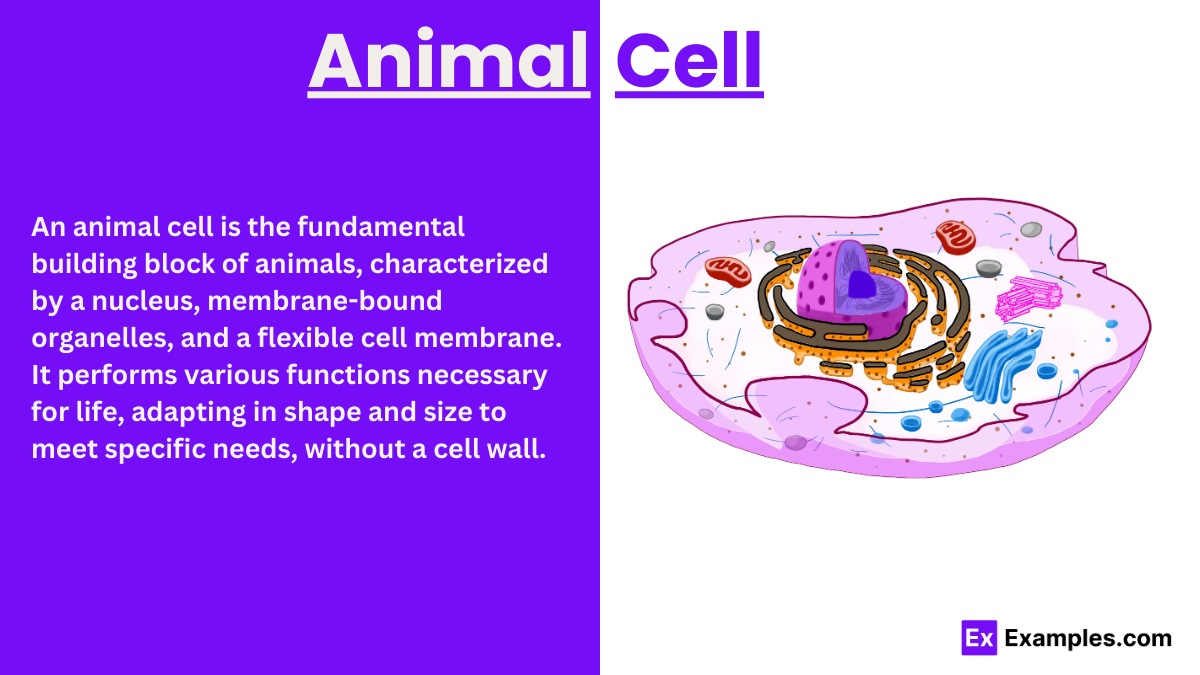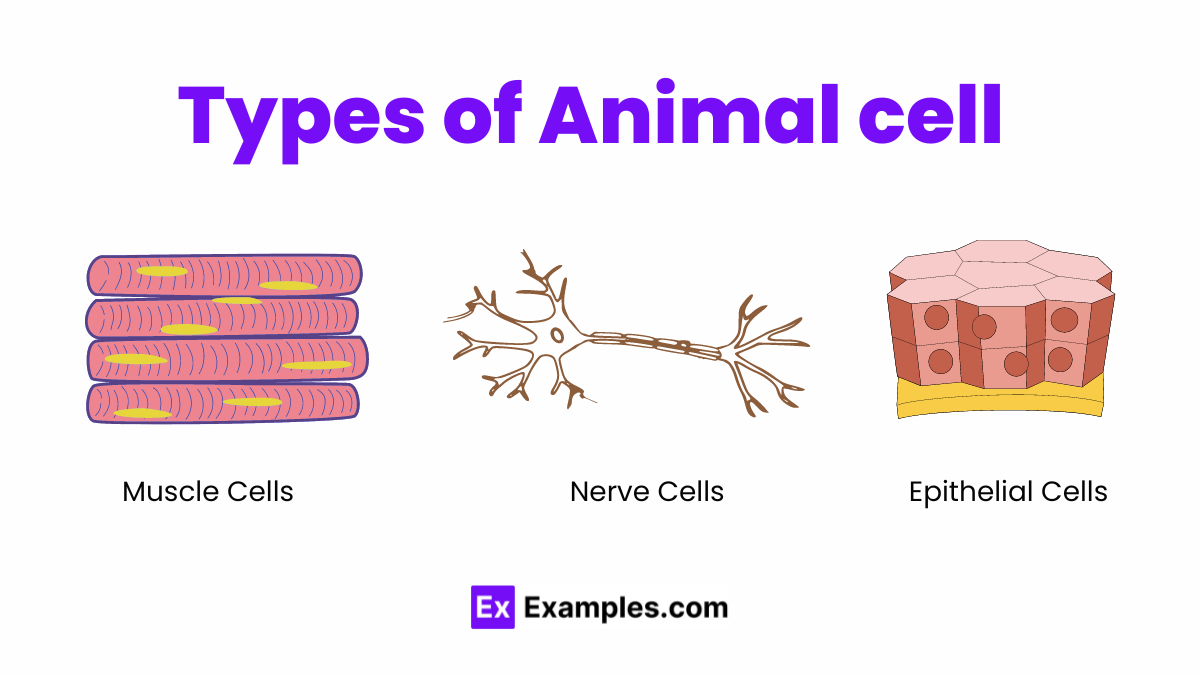Which organelle is known as the powerhouse of the cell?
Nucleus
Ribosome
Mitochondrion
Golgi apparatus

The animal cell, a marvel of nature’s design, stands as the cornerstone of all animal life. Enclosed by a flexible plasma membrane, it distinguishes itself with a membrane-bound nucleus and intricate organelles, devoid of the rigid cell wall found in plant cells. This trait, lost over eons, underscores the animal cell’s evolutionary journey. Typically invisible to the naked eye, these cells range from 1 to 100 micrometers, revealing their complexity only under the microscope’s gaze. As a pivotal example of eukaryotic cells, animal cells encapsulate the complexity and dynamism that underpin the biological tapestry of the animal kingdom.
An animal cell is like a tiny, bustling city within a microscopic space. It’s the basic building block of all animals, flexible in shape and packed with special parts. At its center is the nucleus, acting like city hall with all the genetic plans. Surrounding it, structures like mitochondria provide energy, while ribosomes produce proteins. All animal cells are eukaryotic, meaning they have a nucleus enclosed in a membrane. Despite their diverse functions and shapes, from nerve cells to muscle cells, they all work together to form the tissues and organs of animals, making life as we know it possible.

An animal cell is like a tiny city, with the nucleus as its control center holding all the genetic blueprints. The cell membrane surrounds the cell, acting like a gatekeeper to regulate what enters and exits. Inside, organelles such as mitochondria and ribosomes serve as power stations and factories, producing energy and proteins needed for the cell’s survival and function. This compact, complex structure enables animal cells to carry out life’s essential processes.
The plasma membrane, a flexible and selectively permeable barrier, encloses the animal cell. Composed of a phospholipid bilayer with embedded proteins, it controls the movement of substances in and out, maintaining the cell’s internal balance. This membrane’s fluid nature allows for dynamic interactions, essential for communication and nutrient exchange.
At the heart of the animal cell lies the nucleus, the repository of genetic material (DNA) and the site for RNA synthesis. Surrounded by the nuclear envelope, a double membrane with pores for material exchange, the nucleus coordinates cell activities such as growth, division, and protein synthesis, guided by the genetic instructions housed within.
Mitochondria are key to energy production, converting nutrients into ATP through cellular respiration. Their unique double-membrane structure, with an inner membrane folded into cristae, maximizes the surface area for energy-generating chemical reactions. Mitochondria also play roles in cell signaling, cellular differentiation, and the control of the cell cycle.
The ER is a network of membranous tubules and sacs, functioning as the site for protein and lipid synthesis. It is divided into two regions: the rough ER, studded with ribosomes, where protein synthesis occurs, and the smooth ER, involved in lipid synthesis, detoxification, and calcium storage. The ER plays a critical role in modifying proteins and preparing them for transport to their destination.
The Golgi apparatus consists of stacked, flattened membranous sacs responsible for modifying, sorting, and packaging proteins and lipids received from the ER. Through vesicles, it dispatches these molecules to their intended locations within or outside the cell, including the plasma membrane and lysosomes.
Lysosomes are membrane-bound organelles filled with enzymes that break down waste materials, cellular debris, and foreign invaders. By recycling the cell’s organic material, they play a crucial role in cell maintenance and survival.
The cytoskeleton, a network of protein filaments and tubules, provides structural support, maintaining the cell’s shape, and facilitates movement, both within the cell (transporting organelles and molecules) and for the cell itself. Components include microfilaments, intermediate filaments, and microtubules, each with specific roles in cell stability, intracellular transport, and division.
Centrioles are cylindrical structures that play a vital role in cell division, organizing the microtubules that separate chromosomes during mitosis. In some animal cells, centrioles also form the bases of cilia and flagella, structures involved in cell movement and fluid movement across the cell surface.

Animal cells come in many forms, each designed for a specific role. Nerve cells handle communication, sending signals throughout the body. Muscle cells allow movement by contracting and relaxing. Blood cells are vital too, with red ones transporting oxygen and white ones fighting off infections. Then there are skin cells for protection, fat cells for energy storage, and many others, all playing their part in keeping the body functioning smoothly. Despite their varied functions, these cells share basic animal cell features, working together to sustain life.
Muscle cells, or myocytes, are specialized to contract and produce force, enabling movement and support across the animal body. There are three types: skeletal, cardiac, and smooth muscle cells. Skeletal muscle cells are cylindrical, multi-nucleated, and voluntary, responsible for body movement. Cardiac muscle cells, found in the heart, are branched, interconnected, and beat involuntarily to pump blood. Smooth muscle cells, lining organs like the stomach and blood vessels, involuntarily control the internal movement of substances.
Nerve cells, or neurons, form the basis of the nervous system, transmitting signals across the body to coordinate action and response to the environment. These cells have a unique structure, including dendrites to receive signals, a cell body to process information, and a long axon to transmit signals to other cells. Neurons are essential for sensory perception, thought, movement, and homeostatic processes.
Epithelial cells cover the body’s surfaces and line its cavities, providing protection, absorption, secretion, and sensation functions. They are tightly packed to form epithelial tissue, which acts as a barrier against pathogens and fluid loss. Depending on their location and role, epithelial cells can be squamous (flat), cuboidal, or columnar in shape.
Blood cells, circulating through the body’s cardiovascular system, are crucial for transport, defense, and regulatory functions. Red blood cells (erythrocytes) carry oxygen from the lungs to tissues and remove carbon dioxide. White blood cells (leukocytes) defend against infection and disease. Platelets, or thrombocytes, aid in blood clotting to prevent bleeding.
Fat cells, or adipocytes, store energy in the form of fat and play essential roles in metabolism, insulation, and cushioning of organs. These cells can expand many times their size to accommodate additional fat, making them key players in energy regulation and metabolic health.
Connective tissue cells support, connect, or separate different types of tissues and organs in the body. This category includes fibroblasts (producing connective tissue fibers), osteocytes (forming bone), chondrocytes (forming cartilage), and adipocytes (storing fat). These cells provide structural integrity, support, and protection across the body.
Animal cells are the foundational units of life in animals, executing a myriad of functions vital for survival, growth, and reproduction. This guide delves into the core functions of animal cells, offering a detailed, SEO-optimized, and NLP-friendly perspective. By emphasizing “Animal cell functions,” we aim to enrich readers’ understanding of these biological wonders, spotlighting their significance in the broader context of life sciences.
At the heart of an animal cell’s function is energy production, primarily carried out by mitochondria. These organelles convert glucose and oxygen into adenosine triphosphate (ATP), the energy currency of the cell, through the process of cellular respiration. This energy fuels various cellular activities, including movement, synthesis of molecules, and active transport mechanisms.
Protein synthesis is a critical function of animal cells, involving the translation of genetic information from DNA into proteins. Proteins serve as enzymes, structural components, signaling molecules, and transporters, among other roles. The nucleus, ribosomes, endoplasmic reticulum (ER), and Golgi apparatus collaborate in this complex process, ensuring the cell’s structural integrity and functionality.
The nucleus, a defining feature of eukaryotic cells, including animal cells, stores genetic material (DNA) and coordinates its replication and transcription. This function is crucial for cell division and the inheritance of genetic traits, enabling organisms to grow, repair damaged tissues, and reproduce.
Animal cells communicate and respond to their environment through signaling pathways, involving receptors on the cell membrane that detect specific molecules, such as hormones and neurotransmitters. These signals trigger responses within the cell, such as altering gene expression, modifying cellular activities, or initiating cell division, ensuring the organism’s adaptation and survival.
Lysosomes and peroxisomes in animal cells are key to waste removal and recycling. Lysosomes contain enzymes that break down macromolecules, damaged organelles, and pathogens, recycling their components. Peroxisomes neutralize toxic substances, including hydrogen peroxide, protecting the cell from oxidative damage.
Animal cells undergo cell division, primarily through the process of mitosis, enabling organisms to grow, replace worn-out cells, and heal injuries. This function is regulated by a complex network of signals to ensure proper timing, coordination, and formation of new cells, maintaining the health and vitality of the organism.
Beyond these fundamental roles, animal cells exhibit specialized functions depending on their type and location. For example, nerve cells (neurons) transmit electrical signals, muscle cells contract to produce movement, and red blood cells transport oxygen. This specialization underpins the complex structure and behavior of multicellular organisms, allowing for diverse life forms and adaptive capabilities.
An animal cell is a basic unit of life in multicellular animals, characterized by a lack of cell walls and chloroplasts, containing a nucleus and various organelles.
Key parts include the nucleus, mitochondria, endoplasmic reticulum, Golgi apparatus, lysosomes, and plasma membrane, each with specific functions vital for the cell’s operation.
Animal cells lack cell walls and chloroplasts, present in plant cells. They often have smaller vacuoles and are more flexible in shape compared to plant cells.
The nucleus acts as the control center, storing genetic material (DNA) and coordinating activities like growth, metabolism, and protein synthesis through gene expression.
Animal cells produce energy primarily through mitochondria, which convert glucose and oxygen into ATP via cellular respiration, powering various cellular activities.
Animal cells form tissues and organs, performing specific functions like transporting oxygen (red blood cells), muscle contraction (muscle cells), and signaling (nerve cells).
Text prompt
Add Tone
Types of Animal Cells
Functions of Animal Cells
Which organelle is known as the powerhouse of the cell?
Nucleus
Ribosome
Mitochondrion
Golgi apparatus
Which of the following structures is unique to animal cells?
Chloroplast
Cell wall
Centriole
Large central vacuole
Where does protein synthesis occur in an animal cell?
Nucleus
Ribosome
Mitochondrion
Golgi apparatus
Which organelle is responsible for modifying, sorting, and packaging proteins?
Endoplasmic reticulum
Golgi apparatus
Lysosome
Mitochondrion
Which of the following is not a function of the plasma membrane?
Transport of substances in and out of the cell
Protection of the cell
Energy production
Cell communication
What is the main function of lysosomes?
Protein synthesis
Digestion and waste removal
DNA storage
Lipid synthesis
The rough endoplasmic reticulum is associated with:
Lipid synthesis
Carbohydrate metabolism
Protein synthesis
DNA replication
Which structure is involved in cell movement and structure?
Mitochondria
Nucleolus
Endoplasmic reticulum
Cytoskeleton
The fluid component inside the cell that contains organelles is called:
Cytoplasm
Nucleoplasm
Stroma
Plasma
Which of the following structures are found in both animal and plant cells?
Chloroplasts
Cell wall
Mitochondria
Large central vacuole
Before you leave, take our quick quiz to enhance your learning!

